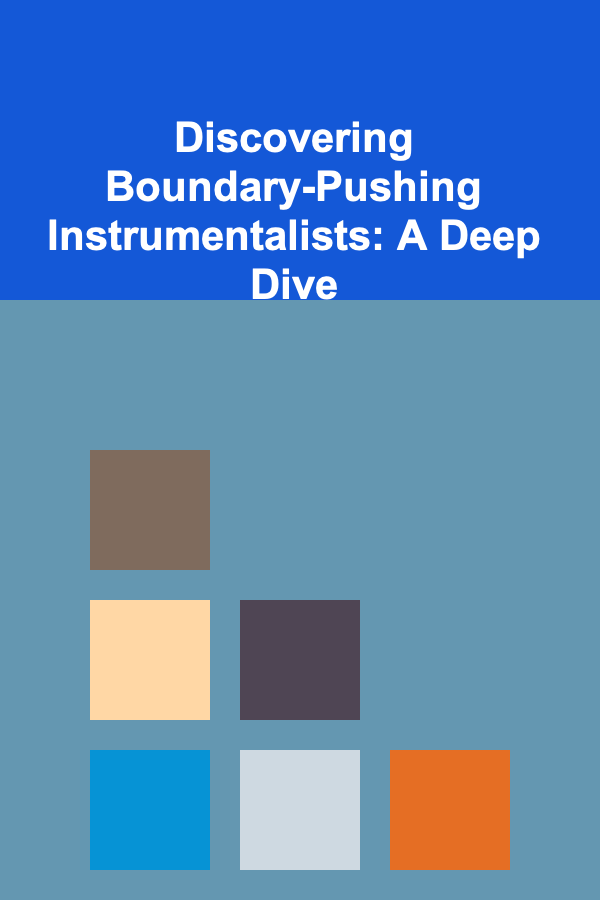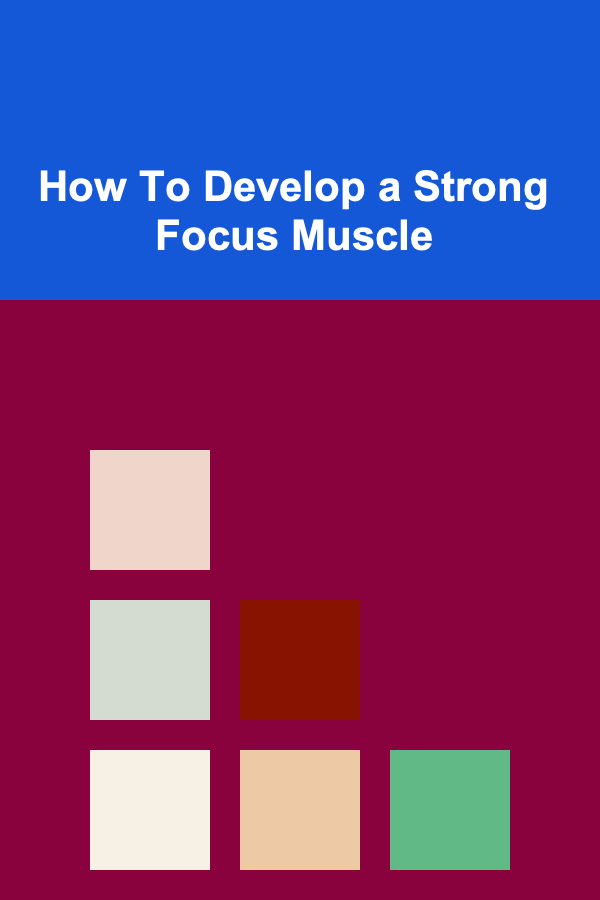
Discovering Boundary-Pushing Instrumentalists: A Deep Dive
ebook include PDF & Audio bundle (Micro Guide)
$12.99$5.99
Limited Time Offer! Order within the next:

The world of instrumental music is a vast and ever-evolving landscape, populated by artists who continually redefine the limits of their craft. Identifying instrumentalists who truly push boundaries requires more than just casual listening; it demands a proactive and nuanced approach to exploration. This essay aims to provide a comprehensive guide to discovering such artists, exploring the various avenues available and the critical considerations involved in recognizing genuine innovation.
Defining "Boundary-Pushing": A Shifting Sands
Before embarking on the discovery journey, it's crucial to define what we mean by "boundary-pushing." This isn't simply about technical virtuosity, though that can certainly be a component. True boundary-pushing in instrumental music encompasses several key elements:
- Innovation in Technique: This involves developing new playing techniques, extending the capabilities of an instrument beyond its perceived limitations. Think of Jimi Hendrix's pioneering use of feedback and whammy bar techniques on the guitar, or Béla Fleck's radical expansions of banjo vocabulary.
- Exploration of Unconventional Timbre and Soundscapes: Boundary-pushers often venture into uncharted sonic territories, utilizing extended techniques (such as prepared piano or bowing a guitar with a violin bow), electronic effects, or unconventional instruments to create unique and evocative soundscapes.
- Genre Fusion and Hybridization: Combining disparate genres in novel and unexpected ways is a hallmark of boundary-pushing. Consider the blending of jazz improvisation with classical structures by artists like the Modern Jazz Quartet, or the fusion of progressive rock with world music by bands like King Crimson.
- Recontextualization of Tradition: Taking established musical traditions and reinterpreting them through a contemporary lens can be a powerful form of boundary-pushing. This might involve incorporating electronic elements into traditional folk music, or applying jazz harmonies to classical compositions.
- Conceptual Depth and Narrative: Beyond mere technical prowess, boundary-pushing instrumentalists often use their music to explore complex themes, tell compelling stories, or evoke profound emotional responses. This might involve creating concept albums that explore philosophical ideas or composing pieces that reflect on social issues.
It's important to remember that "boundary-pushing" is subjective and context-dependent. What was considered radical in one era may become commonplace in another. Therefore, a critical and open-minded approach is essential when evaluating an instrumentalist's contribution.
Avenues for Discovery: Casting a Wide Net
The digital age offers unprecedented access to music from around the globe, providing numerous avenues for discovering boundary-pushing instrumentalists. Here are some of the most effective strategies:
1. Streaming Platforms and Algorithmic Recommendations:
Services like Spotify, Apple Music, and YouTube Music utilize sophisticated algorithms that analyze listening habits and suggest new artists based on your preferences. While these algorithms can sometimes lead to predictable results, they can also be surprisingly effective at surfacing lesser-known artists who share stylistic similarities with your favorite musicians. To maximize the effectiveness of these recommendations, consider the following:
- Curate Your Playlists: Create diverse playlists that showcase a wide range of instrumental genres and styles. This will provide the algorithm with a broader dataset to work with, increasing the likelihood of discovering unexpected gems.
- Explore Genre-Specific Playlists: Streaming platforms often feature curated playlists focused on niche genres, such as "Experimental Jazz," "Ambient Electronic," or "Progressive Folk." These playlists can be a great starting point for exploring specific areas of instrumental innovation.
- Pay Attention to "Related Artists": When you find an artist you enjoy, explore the "related artists" section on the streaming platform. This is often a reliable way to discover similar musicians who may be pushing boundaries in similar ways.
- Don't Be Afraid to Experiment: Step outside your comfort zone and listen to genres you're unfamiliar with. You might be surprised at what you discover.
However, be mindful of algorithmic bias. Streaming algorithms tend to favor popular artists and may not always surface truly obscure or experimental musicians. It's crucial to supplement algorithmic recommendations with other discovery methods.
2. Online Music Communities and Forums:
Online communities dedicated to specific genres or instruments can be invaluable resources for discovering boundary-pushing instrumentalists. These communities often consist of passionate fans, musicians, and critics who are deeply knowledgeable about their respective fields. Consider joining forums, subreddits, or social media groups dedicated to genres like progressive rock, avant-garde jazz, experimental electronic music, or specific instruments like the harp or theremin. Active participation in these communities can lead to recommendations for artists you might not otherwise encounter.
Look for discussions about:
- "Hidden Gems": Threads dedicated to showcasing underrated or overlooked artists.
- "Most Innovative" Artists: Discussions where members nominate artists who are pushing the boundaries of their instrument or genre.
- "New Releases": Threads that highlight recently released albums or singles by up-and-coming instrumentalists.
Be prepared to engage in respectful dialogue and contribute your own insights to the community. The more you participate, the more likely you are to receive valuable recommendations.
3. Independent Music Blogs and Publications:
Numerous independent music blogs and publications are dedicated to covering emerging and experimental artists. These publications often provide in-depth reviews, interviews, and features that can offer valuable insights into the creative process and artistic vision of boundary-pushing instrumentalists. Look for blogs that specialize in the genres that interest you most, and pay attention to the writers who consistently highlight innovative and forward-thinking artists.
Some reputable sources include:
- Pitchfork: While known for its coverage of mainstream music, Pitchfork also features reviews of experimental and avant-garde artists.
- The Quietus: A UK-based online magazine that focuses on alternative and experimental music.
- Tiny Mix Tapes: A blog that covers a wide range of genres, with a particular emphasis on experimental and independent music.
- Bandcamp Daily: Bandcamp's editorial arm, which features articles and interviews with artists who sell their music on the platform.
Remember that critical perspective is crucial. Read reviews with an open mind and consider the reviewer's biases. Ultimately, the best way to determine whether an artist is truly boundary-pushing is to listen to their music yourself.
4. Live Performances and Festivals:
Attending live performances and music festivals is an excellent way to discover boundary-pushing instrumentalists in a more immersive and dynamic environment. Live performance can reveal aspects of an artist's musicianship and stage presence that are not apparent in recordings. Look for festivals that focus on experimental, avant-garde, or genre-bending music. These festivals often feature lineups of cutting-edge artists who are pushing the boundaries of their respective fields.
Consider attending festivals like:
- Big Ears Festival (Knoxville, TN): A festival that showcases a diverse range of experimental and avant-garde music, including jazz, classical, electronic, and world music.
- Moogfest (Durham, NC): A festival that celebrates the legacy of Robert Moog and explores the intersection of music, art, and technology.
- Le Guess Who? (Utrecht, Netherlands): A festival that features a curated lineup of international artists from a wide range of genres, with a focus on experimental and boundary-pushing music.
Even local venues can host surprisingly innovative acts. Check listings for experimental music nights or showcases featuring up-and-coming instrumentalists.
5. Academic Institutions and Conservatories:
Music schools and conservatories are often hotbeds of innovation, as students and faculty members experiment with new techniques and approaches to instrumental music. Many academic institutions host concerts and recitals that feature original compositions and performances by students and faculty. Attending these events can provide a glimpse into the future of instrumental music and expose you to artists who are pushing the boundaries of their craft within a rigorous academic environment.
Look for institutions with strong programs in:
- Contemporary Music Performance: Programs that focus on the performance of contemporary classical music and experimental music.
- Jazz Studies: Programs that encourage students to explore improvisation and composition beyond traditional jazz forms.
- Electronic Music Production: Programs that teach students how to create and perform electronic music using synthesizers, samplers, and other digital tools.
Contact the music department of local universities and conservatories to inquire about upcoming concerts and recitals.
6. Collaboration and "Six Degrees of Separation":
Often, boundary-pushing instrumentalists are connected through collaborative projects. Once you discover an artist who resonates with you, research their collaborations. Who have they worked with? Which musicians have they cited as influences? Following these connections can lead you down a rabbit hole of discovery, uncovering a network of like-minded artists who are all pushing boundaries in their own ways. This is a particularly effective strategy in genres like jazz and experimental electronic music, where collaboration is a common practice.
Critical Listening: Discerning Genuine Innovation
Simply finding new instrumentalists is not enough. It is crucial to develop a critical ear to discern genuine innovation from mere novelty. Ask yourself the following questions when evaluating an artist's work:
- Is this truly new, or just a variation on existing ideas? Does the artist offer a fresh perspective on established musical traditions, or are they simply rehashing familiar tropes?
- Is the technical virtuosity serving a musical purpose? Is the artist using their technical skills to express something meaningful, or are they simply showing off?
- Does the music evoke an emotional response? Does the music move you, challenge you, or inspire you in some way?
- Does the artist demonstrate a clear artistic vision? Does the music feel cohesive and intentional, or does it seem disjointed and haphazard?
- Does the artist challenge my assumptions about what instrumental music can be? Does the music push you outside your comfort zone and force you to reconsider your preconceived notions?
It's also important to consider the context in which the music was created. What were the prevailing musical trends at the time? What were the artist's influences? Understanding the historical and cultural context can help you appreciate the significance of an artist's contribution.
Be wary of hype and superficial trends. True boundary-pushing often takes time to be recognized and appreciated. Don't be swayed by fleeting popularity or sensationalism. Focus on the substance of the music and the artist's artistic vision.
Examples of Boundary-Pushing Instrumentalists (Across Genres):
To illustrate the concepts discussed above, here are a few examples of instrumentalists who have demonstrably pushed boundaries in their respective fields:
- Béla Fleck (Banjo): Fleck has revolutionized the banjo, taking it far beyond its traditional bluegrass context and incorporating elements of jazz, classical, and world music. His innovative techniques and eclectic compositions have earned him widespread critical acclaim and numerous Grammy Awards.
- Laurie Anderson (Violin/Electronics): Anderson is a pioneer of performance art and experimental music, known for her innovative use of electronic effects and her spoken-word performances. She has pushed the boundaries of what a violin can be, using it as a tool for sonic exploration and storytelling.
- Tosin Abasi (Guitar): Abasi is a virtuosic guitarist who has redefined the boundaries of progressive metal. His innovative tapping techniques, complex polyrhythms, and unconventional song structures have influenced a generation of guitarists.
- Anoushka Shankar (Sitar): Shankar is a world-renowned sitar player who has collaborated with artists from a wide range of genres, including classical, jazz, and electronic music. She has pushed the boundaries of traditional Indian classical music by incorporating contemporary elements and exploring new sonic possibilities.
- Colin Stetson (Saxophone): Stetson is a saxophone virtuoso who uses circular breathing and extended techniques to create dense and hypnotic soundscapes. His solo performances are captivating displays of instrumental mastery and sonic innovation.
- Anna von Hausswolff (Pipe Organ): Von Hausswolff crafts dark and atmospheric music centered around the pipe organ, blending elements of drone, gothic rock, and experimental music. She uses the instrument to create powerful and evocative soundscapes that challenge conventional notions of beauty and harmony.
These are just a few examples; countless other instrumentalists are pushing boundaries in their own unique ways. The key is to remain curious, open-minded, and proactive in your search.
The Ongoing Journey: Embracing the Unexpected
Discovering boundary-pushing instrumentalists is not a destination but an ongoing journey. The landscape of instrumental music is constantly evolving, and new artists are always emerging to challenge the status quo. By embracing curiosity, cultivating critical listening skills, and actively seeking out new and innovative music, you can embark on a rewarding exploration of the limitless possibilities of instrumental expression.
Remember that the most exciting discoveries often come from unexpected places. Be willing to venture off the beaten path, explore unfamiliar genres, and challenge your own assumptions about what instrumental music can be. The rewards of such exploration are immeasurable, offering a deeper appreciation for the power and potential of music to transcend boundaries and connect us to something larger than ourselves.
Ultimately, the goal is not simply to find artists who are "different" for the sake of being different. The goal is to find artists who are using their instruments to create something meaningful, profound, and transformative. When you discover an instrumentalist who truly pushes boundaries, you are not just listening to music; you are witnessing the evolution of art.
So, listen widely, listen deeply, and embrace the adventure.

How to Use Accent Chairs to Balance Furniture Layout
Read More
How To Write Short Stories That Captivate
Read More
How To Understand Robot Design Principles
Read More
How To Develop a Strong Focus Muscle
Read More
How to Fundraise for Specialized Animal Rescue Needs
Read More
10 Tips for Optimizing Warehouse Layout as a Logistics Coordinator
Read MoreOther Products

How to Use Accent Chairs to Balance Furniture Layout
Read More
How To Write Short Stories That Captivate
Read More
How To Understand Robot Design Principles
Read More
How To Develop a Strong Focus Muscle
Read More
How to Fundraise for Specialized Animal Rescue Needs
Read More